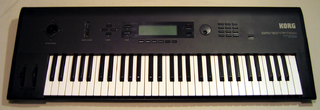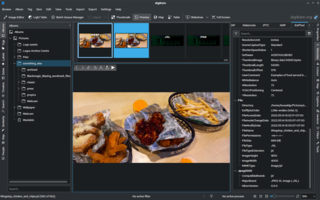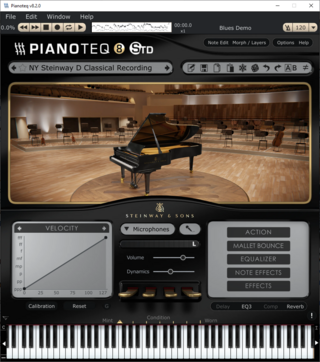Related Research Articles

Microsoft SideWinder is a former brand name for a family of video gaming peripherals developed by Microsoft for PCs. It was initially marketed from 1995 to 2003 consisting of game controllers, then again from 2007 until the early 2010s with gaming mice and keyboards.
SuperCollider is an environment and programming language originally released in 1996 by James McCartney for real-time audio synthesis and algorithmic composition.

A digital audio workstation is an electronic device or application software used for recording, editing and producing audio files. DAWs come in a wide variety of configurations from a single software program on a laptop, to an integrated stand-alone unit, all the way to a highly complex configuration of numerous components controlled by a central computer. Regardless of configuration, modern DAWs have a central interface that allows the user to alter and mix multiple recordings and tracks into a final produced piece.
FastTracker 2 is a music tracker created by Fredrik "Mr. H" Huss and Magnus "Vogue" Högdahl, two members of the demogroup Triton who set about releasing their own tracker after breaking into the scene in 1992 and winning several demo competitions. The source code of FastTracker 2 is written in Pascal using Borland Pascal 7 and TASM. The program works natively under MS-DOS.

Module file is a family of music file formats originating from the MOD file format on Amiga systems used in the late 1980s. Those who produce these files and listen to them form the worldwide MOD scene, a part of the demoscene subculture.
SoundFont is a brand name that collectively refers to a file format and associated technology that uses sample-based synthesis to play MIDI files. It was first used on the Sound Blaster AWE32 sound card for its General MIDI support.
Logic Pro is a proprietary digital audio workstation (DAW) and MIDI sequencer software application for the macOS platform developed by Apple Inc. It was originally created in the early 1990s as Notator Logic, or Logic, by German software developer C-Lab which later went by Emagic. Apple acquired Emagic in 2002 and renamed Logic to Logic Pro. It was the second most popular DAW – after Ableton Live – according to a survey conducted in 2015.

The Option key, ⌥, is a modifier key present on Apple keyboards. It is located between the Control key and the Command key on a typical Mac keyboard. There are two Option keys on modern Mac desktop and notebook keyboards, one on each side of the space bar.
Prodikeys is a music and computer keyboard. It was created by Singaporean audio company Creative Technology. So far, three different versions of Prodikeys have been launched: Creative Prodikeys, Creative Prodikeys DM and Creative Prodikeys PC-MIDI.
Final Scratch is a DJ tool created by the Dutch company N2IT with input from Richie Hawtin and John Acquaviva that allows manipulation and playback of digital audio sources using traditional vinyl and turntables. It seeks to cross the divide between the versatility of digital audio and the tactile control of vinyl turntablism.

Hydrogen is an open-source drum machine created by Alessandro Cominu, an Italian programmer who goes by the pseudonym Comix. Its main goal is to provide professional yet simple and intuitive pattern-based drum programming.

Music visualization or music visualisation, a feature found in electronic music visualizers and media player software, generates animated imagery based on a piece of music. The imagery is usually generated and rendered in real time and in a way synchronized with the music as it is played.

GoldWave is a commercial digital audio editing software product developed by GoldWave Inc, first released to the public in April 1993.

The Korg Wavestation is a vector synthesis synthesizer first produced in the early 1990s and later re-released as a software synthesizer in 2004. Its primary innovation was Wave Sequencing, a method of multi-timbral sound generation in which different PCM waveform data are played successively, resulting in continuously evolving sounds. The Wavestation's "Advanced Vector Synthesis" sound architecture resembled early vector synths such as the Sequential Circuits Prophet VS.

A tag editor is an app that can add, edit, or remove embedded metadata on multimedia file formats. Content creators, such as musicians, photographers, podcasters, and video producers, may need to properly label and manage their creations, adding such details as title, creator, date of creation, and copyright notice.

LMMS is a digital audio workstation application program. It allows music to be produced by arranging samples, synthesizing sounds, entering notes via computer keyboard or mouse or by playing on a MIDI keyboard, and combining the features of trackers and sequencers. It is free and open source software, written in Qt and released under GPL-2.0-or-later.
Protracker is a music tracker for the Amiga platform. A free software tool that required no additional equipment, it became popular in the early 1990s with both amateurs and professionals, allowing for sample-based music in the MOD file format.

WaveSurfer is an audio editor widely used for studies of acoustic phonetics. It is a simple but fairly powerful program for interactive display of sound pressure waveforms, spectral sections, spectrograms, pitch tracks and transcriptions. It can read and write a number of transcription file formats used in industrial speech research including TIMIT.

Pianoteq is a software synthesizer that features real-time MIDI-control of digital physically modeled pianos and related instruments, including electric piano, harp, harpsichord, fortepiano, and various metallophones. It is usable as a stand-alone program for Microsoft Windows, Mac OS X, iOS, iPadOS and Linux platforms, or as a plug in for VSTi hosts and two VSTi counterpart for use with digital audio workstations.